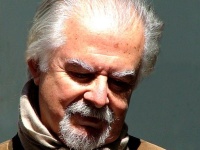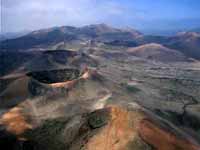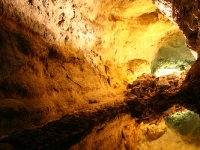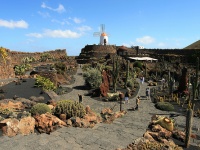Lanzarote Travel Guide
The most northeasterly of the Canary Islands, Lanzarote has embraced the tourism boom with a more laidback feel than its popular sister islands of Tenerife and Gran Canaria. Nature is still the biggest attraction on this small volcanic island, which measures only 38 miles (60km) in length and 13 miles (21km) across at its widest point.
Lanzarote's beaches are varied and dramatic, including long stretches of golden sand, some good surf spots, and some rugged, hidden coves. Camels are often used to transport goods and sometimes tourists on this desert-like island, where dry volcanic ash covers most of the landscape. UNESCO declared the whole island a Biosphere Reserve in 1993, and visitors exploring the dozens of enchanting and unique spots on the island will soon see why.
Lanzarote's capital, Arrecife, is a small town on the eastern coast and its harbour is packed with fishing boats. Although the town itself has little to offer in the way of sights or nightlife, it does have a magnificent beach, El Reducto, which has been granted Blue Flag status by the European Union. A promenade runs along the beachfront around the San Gines lagoon, which has fine golden sand and placid waters.
Things to do in Lanzarote
Lanzarote's chief attractions are its resort towns, which offer crystalline waters and fine beaches, plus some of the most reliably balmy weather in the world. Although the flattest of the Canary Islands, Lanzarote is also of volcanic origin and so has a dramatic landscape that's punctuated with many caves and lagoons.
Those travelling with kids in should visit the Aquapark on the outskirts of Costa Teguise for fun water slides and rides, or enjoy the Submarine Safari near Puerto Calero, which takes passengers on an underwater expedition for an hour, allowing everybody to observe the wonderful marine life. Closer to Arrecife there is a fun go-karting facility with really good tracks and cars for kids and adults to race around in.
Guinate Tropical Park, at the northern tip of the island near the village of Maguez, has incredible bird life and water features, and Rancho Texas, a wild west theme park doubling up as an excellent zoo, near Puerto del Carmen, is one of the most exciting kids' attractions on the island.
Lanzarote is small and easy to navigate; most of the major resorts and attractions are within ten miles (16km) of each other. Efficient bus services (known as guagua) travel around and between the main resorts, and operate until quite late. Taxis are also easily available and fairly good value. Those going off the beaten track may wish to hire a car for a day or two; car rental companies have offices in all the main resorts.

Arrecife Museum of Contemporary Art
A collection of modern artworks sit on permanent display in the Castle of San Jose, a fortress in built in 1779 to defend against pirate attacks in Arrecife. The castle was in military use till 1890 and then stood vacant till 1974, when it was converted into a modern art gallery and restaurant by architect and artist Cesar Manrique. The Museo International de Arte Contemporaneo is small but fascinating. The main attraction is actually the building itself and the contrast between the old fortress and modern art. Some of the artists featured are Bacon, Picasso, Miro, Botero, Damaso, and Luis Feito.

Timanfaya National Park
Timanfaya National Park, in the southwestern part of the island of Lanzarote, is unique because it's the only national park in the world to have been developed by local residents. Also unique is what the park offers, which includes a volcanic field filled with a variety of geological and geothermic phenomena. In fact, the reserve is almost entirely made up of volcanic soil, and volcanic activity continues beneath the surface, although there is only one active volcano. Attractions include some geysers by the restaurant. Although the landscape is strange and stark, 180 different plant species do survive in the park. The whole of Lanzarote is a UNESCO Biosphere Reserve, and Timanfaya is one of the core protected areas.

La Cueva de los Verdes
The spectacular system of underground grottos known as La Cueva de los Verdes lies in the northern part of Lanzarote, close to the Monte de la Corona volcano. At just over four miles (6km), this is one of the largest volcanic galleries in the world, and was formed approximately five thousand years ago in a prehistoric eruption when a massive stream of lava boiled down to the sea, hardening around the spaces inflated by gases. Where the tunnel enters the sea there is an underwater section called the Tunnel of Atlantis. More than a mile (2km) of these grottos is accessible to visitors, and lighting effects have been added to accentuate the contours and colours of the weird shapes resulting from the lava flows.

The Cactus Garden
Situated between Guatiza and Mala is an unusual sightseeing attraction that combines art with nature. Artist Cesar Manrique created a work of art in the form of a cactus plantation in an old quarry. The Cactus Garden was Manrique's final piece of work in Lanzarote. More than 7,000 cactuses from well over 1,000 different species from all over the world are represented in the garden, with many coming from Madagascar, Mexico, Chile, Morocco, the US, and the Canary Islands. The plants come in all shapes and sizes and have been arranged beautifully in a landscaped garden with many water features. The site also features a restored windmill, which visitors can climb.
Shopping
Puerto del Carmen is the best shopping destination on the island and has shops of all kinds, from duty-free electrical stores and stalls along The Strip targeting holidaymakers to the excellent clothes shops and boutiques in the Old Town.
The Sunday Market in Teguise is worth a visit for travellers seeking a variety of locally produced goods such as pottery and tablecloths. Costa Teguise itself has a variety of shops around the resort and in the La Cucharas Shopping Complex, which sell all the usual tourist fare for holidaymakers. There are also a few electrical duty-free stores.
Matagorda has a two-storey shopping centre containing a supermarket and souvenir stores, but the shopping is far better at neighbouring Puerto del Carmen. There are good supermarkets in Playa Blanca that sell all the well-known brands and holidaymakers will find that, although the choice is not as good as in Puerto del Carmen, there are a fair number of electrical duty-free stores and other shops geared at tourists near the harbour. For couture shopping, most tourists in Playa Blanca head to the stylish Marina Rubicon.
Nightlife
Puerto del Carmen is the main nightspot on the island and its population swells most evenings as tourists from the other holiday resorts of Lanzarote come to enjoy its bars and clubs. There are loads of good English, Irish and Scottish bars in the New Town along The Strip.
The Centre Atlantico has a number of cocktail bars and can be a good spot to start the evening. The nightlife in Playa Blanca is fairly limited, with entertainment mostly restricted to the shows organised by hotels. There's a kids disco but those after something more hardcore will need to head to Costa Teguise or Puerto del Carmen, half an hour away by car. Similarly, holidaymakers will find that although Matagorda is not lacking in waterfront pubs and bars, most offering some lively evening entertainment, generally nightlife in Matagorda is rather low key.
Younger visitors looking for a taste of nightlife in Spain or a more vibrant night out opt to travel the short distance to the rollicking clubs and bars of Puerto del Carmen. The nightlife in Costa Teguise is also not legendary, though it's probably the second most popular choice for those seeking fun after dark.
Getting Around
Lanzarote is a very small island, so getting around is fairly easy. Travel between resorts and towns on the coast can be done by bus. The bus service is efficient and reasonably priced, but holidaymakers need to keep in mind that the service is not frequent and the journeys are long.
With well-serviced roads, dedicated cycle paths, and light traffic, Lanzarote has a large number of cyclists. Bicycles can be hired on the island; travellers should be warned that there are large hills in town that are tricky to get up for inexperienced cyclists.
Holidaymakers who would like to go island hopping can take a ferry from Orzola Harbour. A trip to the neighbouring island of Fuerteventura takes only 25 minutes. Hiring a car is one of the most comfortable and convenient ways to explore the island quickly and comfortably, as major car hire companies are represented at the airport.
Lanzarote Climate and Weather
Lanzarote has a great climate throughout the year, despite the fact it's technically a desert climate. The average temperature is comfortable all year round, rarely dropping below 60°F (16°C) and seldom rising above 82°F (28°C) during the day.
During the winter it gets cool in the evenings and the sea temperature drops, but it's never really cold. January is the coldest month with temperatures averaging between 57°F (14°C) and 68°F (20°C), and August is the hottest month, when temperatures rarely drop below 70°F (21°C) and peak around 84°F (29°C).
Rainfall in the summer months is almost non-existent, but showers are likely between October and April. Typically, rain showers don't last long and quickly give way to sunshine. Trade winds blow sporadically throughout the year but the windiest month is July, when the cool sea breeze can be refreshing in the summer heat.
The Canary Islands are considered the best winter destination in Spain as it's often still warm enough between December and February to enjoy the beach. However, summer (June to August) remains the most popular time to visit Lanzarote.
Spain travel info
Electricity
The electrical current is 230 volts, 50Hz. European-style two-pin plugs are standard.
Language
Spanish is the official language, but English is widely understood in areas frequented by tourists. Catalan, Galician and Basque are spoken in the relevant areas.
Money
Spain's official currency is the euro (EUR), which is divided into 100 cents. Money can be exchanged at bureaux de change and major hotels, but banks give the best rates. All major credit cards are widely accepted at most hotels, restaurants, and shops. ATMs are widespread and are generally the cheapest and most convenient method of obtaining money.
Tipping
Hotel and restaurant bills usually include service charges, but additional tips are welcomed for services rendered. In established restaurants, tips of about 10 percent are expected. Drivers of metered taxis expect small tips and it's customary to tip about 5 to 10 percent for most services, including guides.
Health
There are no health risks associated with travel to Spain, and no vaccination certificates are required for entry. Medical facilities are good but comprehensive travel insurance is always advised. Spain has a reciprocal health agreement with most EU countries that provides emergency health care for EU travellers on the same terms as Spanish nationals. After Brexit, the Global Health Insurance Card (GHIC) replaced the European Health Insurance Card (EHIC) for UK citizens. The GHIC allows UK citizens access to state healthcare during visits to the EU. The GHIC is not valid in Norway, Iceland, Liechtenstein or Switzerland, nor is it an alternative to travel insurance. EU travellers should take a European Health Insurance Card (EHIC). Travellers should take any medication they require along with them, in its original packaging and accompanied by a signed and dated letter from a doctor detailing what it is and why it is needed.
Safety
Most visits to Spain are trouble-free except for occasional street crime. Petty crime, such as pickpocketing and purse snatching, is most common in larger cities, particularly during holidays, festivals and weekends, and especially on public transport and in tourist areas. Thieves may work alone or in groups; visitors should be wary of strangers who offer or ask for help of any kind, or inform them of a stain on their clothes, as these are often ways of providing a distraction for accomplices. There are also scams involving letters for outstanding traffic fines or Spanish lottery winnings. Travellers can avoid incidents if they exercise all the normal precautions.
Local customs
Smoking in public places is banned and stiff fines will be imposed for smoking in areas such as enclosed public spaces, areas where food is prepared and sold, public transport, non-smoking areas of bars and restaurants, and any places that cater for children. Drinking alcohol in the streets of Madrid and the streets of the Canary and Balearic Islands is illegal.
Doing business
The business culture in Spain is slowly shifting but, for now, it's entrenched in tradition and it can take some time for foreigners to gain a foothold in the Spanish working world. It's important never to undermine authority as hierarchy is central to Spain's business world. Managers tend to make decisions without considering input from their colleagues.
A strong emphasis is placed on social status, character attributes, and personal pride. Success is often hinged upon being well-dressed, honourable, and dignified, while also exhibiting great social skills. Business meetings are generally conducted face-to-face and can go on for long periods, as Spaniards prefer long deliberations in order to avoid uncertainty in corporate dealings. Business meetings in Spain tend to tread a fine line between personal and formal.
Conducting business in Spain can entail navigation through a lot of red tape and bureaucracy. Spanish is the language of business, but some of the larger multinationals conduct meetings in both English and Spanish. Business hours are often quite varied, but generally open by 9am and close in the mid-evening with a two-hour lunch break during the early afternoon.
Business attire is quite conservative with men wearing dark or linen suits, shirts and silk ties. Women should wear modest dresses or tailored suits. Brand names or labels attract affirmation from colleagues and associates.
After the conclusion of successful negotiations, gifts are appropriate. Gifts should be of high quality and, when receiving a gift, it should be opened in front of the giver. Business cards are important and should be bilingual. Meetings are best scheduled for mid-morning, and establishing a formal yet personable environment is important before beginning. Meetings often occur over lunches and dinners.
Duty free
Travellers from EU countries are allowed the following items duty free: 800 cigarettes or 400 cigarillos or 200 cigars or 1kg tobacco; 110 litres beer; 90 litres wine; and 10 litres spirit. Travellers from non-EU countries may have 200 cigarettes or 100 cigarillos or 50 cigars or 250g tobacco; 1 litre spirits, 4 litres wine, and 16 litres beer.
Communications
The international access code for Spain is +34. WiFi is widely available; travellers can purchase local SIM cards for unlocked phones or use eSIMs if their cellular providers support it on their networks.
Passport & Visa
The borderless region known as the Schengen area includes the following countries: Austria, Belgium, Czech Republic, Denmark, Estonia, Finland, France, Germany, Greece, Hungary, Iceland, Italy, Latvia, Lithuania, Luxembourg, Malta, The Netherlands, Norway, Poland, Portugal, Slovakia, Slovenia, Spain, and Sweden. All these countries issue a standard Schengen visa that has a multiple entry option, allowing the holder to travel freely within the borders of all. Non-EU nationals must hold a return or onward ticket, all necessary documents for onward travel and sufficient funds. It is highly recommended that passports have at least six months' validity remaining after the intended date of departure from Spain. Immigration officials often apply different rules to those stated by travel agents and official sources.
Entry requirements
United States citizens require a passport valid for three months beyond the period of intended stay. No visa is required for stays of up to 90 days within a 180 day period.
British citizens require a passport valid for three months beyond the period of intended stay. No visa is required for stays of up to 90 days within a 180 day period.
Canadian citizens require a passport valid for at least three months beyond period of intended stay. No visa is required for stays of up to 90 days within a 180 day period.
Australian citizens require a passport valid for at least three months beyond period of intended stay. No visa is required for stays of up to 90 days within a 180 day period.
South African citizens require a passport valid for at least three months beyond period of intended stay. A visa is required.
Irish nationals require a valid passport, but a visa is not necessary.
New Zealand citizens require a passport valid for at least three months beyond period of intended stay. No visa is required for stays of up to 90 days within a 180 day period.
Useful contacts
Spanish Tourist Office, Madrid: www.spain.info.
112 (General).


